Sonova USA BWRXD Auditory Assistance Device User Manual
Phonak Inc Auditory Assistance Device
User Manual
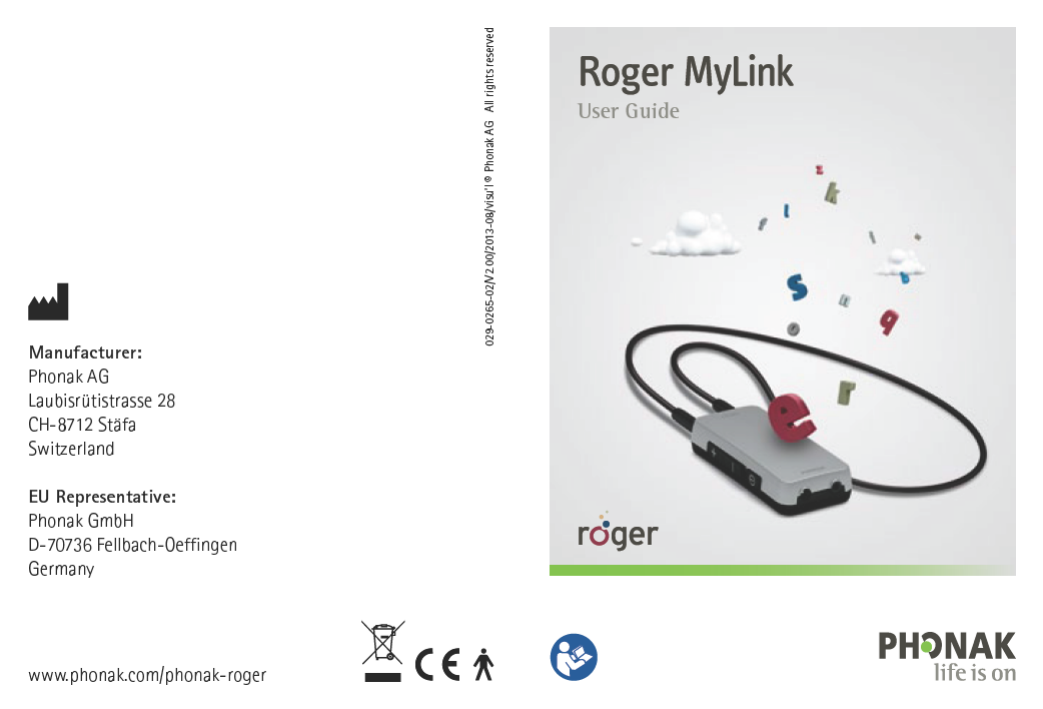

2 3
1. Welcome 5
2. Getting to know your Roger MyLink 6
2.1 Compatibility 7
2.2 Device description 7
2.3 Indicator light 9
3. Getting started 14
Step 1. Charge your Roger MyLink 14
Step 2. Detach the neckloop 16
Step 3. Hang Roger MyLink around the neck
and reattach the loop 16
Step 4. Switch Roger MyLink on 17
Step 5. Choose how to wear Roger MyLink 17
Step 6. Turn on your Roger microphone 18
Step 7. Switch your hearing aid(s) to the
T-Coil program 18
Step 8. Connect Roger MyLink to your
Roger microphone 18
Step 9. Adjust Roger MyLink’s volume 20
Contents
4. Using headphones 21
Step 1. Plug the headphones into
Roger MyLink’s headphone socket 21
Step 2. Turn Roger MyLink on 21
Step 3. Put the headphones on 22
5. More detailed information 23
6. Troubleshooting 24
7. Important information 26
7.1 Hazard warnings 26
7.2 Product safety information 28
7.3 Other important information 31
7.4 International use 32
8. Service and warranty 33
9. Information and explanation of symbols 35

5
1. Welcome
Congratulations on choosing Roger MyLink from Phonak.
Roger MyLink is an easy-to-use and aordable Roger
receiver suitable for use with any hearing aid featuring
a T-Coil (from Phonak or any other manufacturer). Roger
MyLink is compatible with most Roger microphones
from Phonak.
Your Roger MyLink is a Swiss premium-quality product
developed by Phonak, the world’s leading hearing
healthcare company.
Please read this User Guide thoroughly to benefit from
all the possibilities your Roger MyLink oers.
If you have any questions, please consult your hearing
care professional or local Phonak support center.
Phonak – life is on www.phonak.com
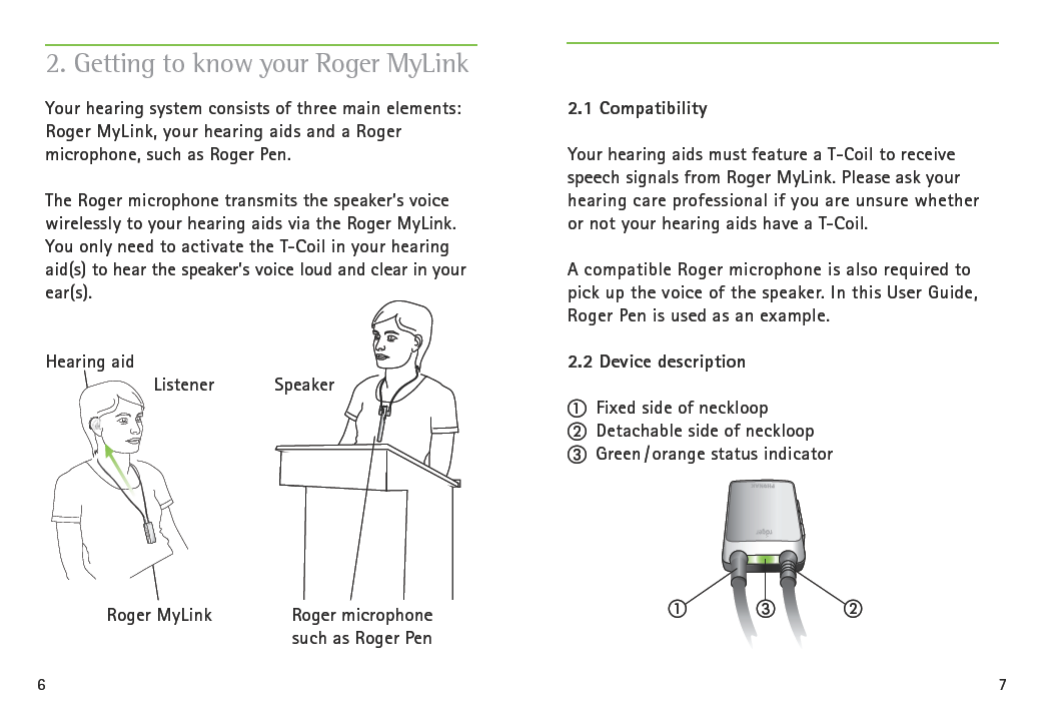
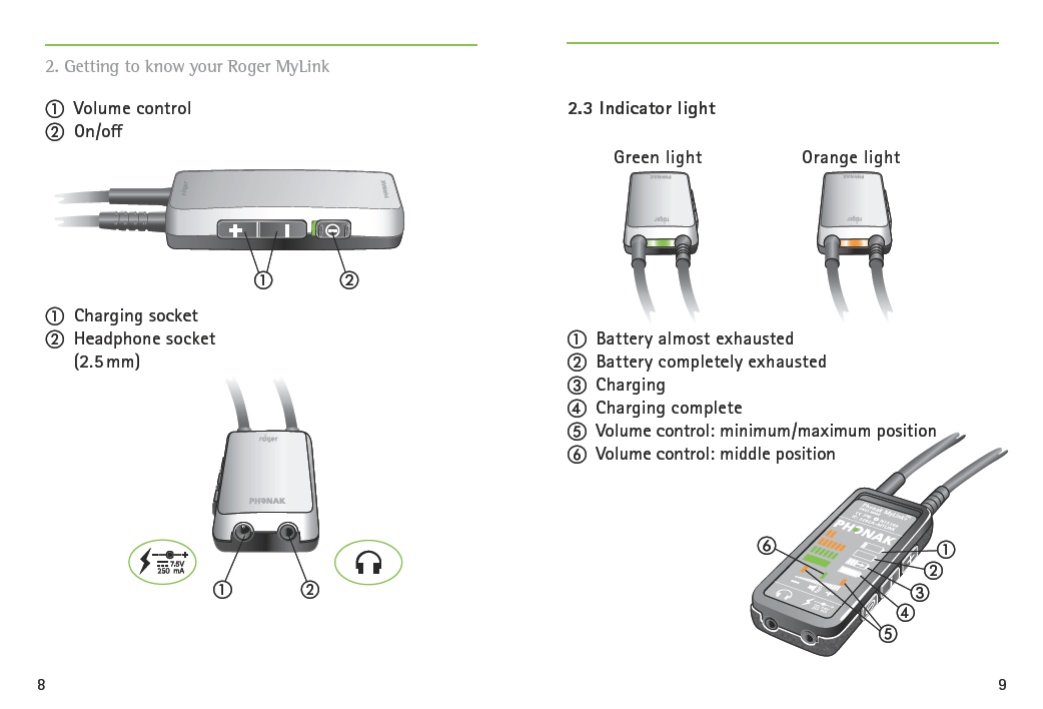
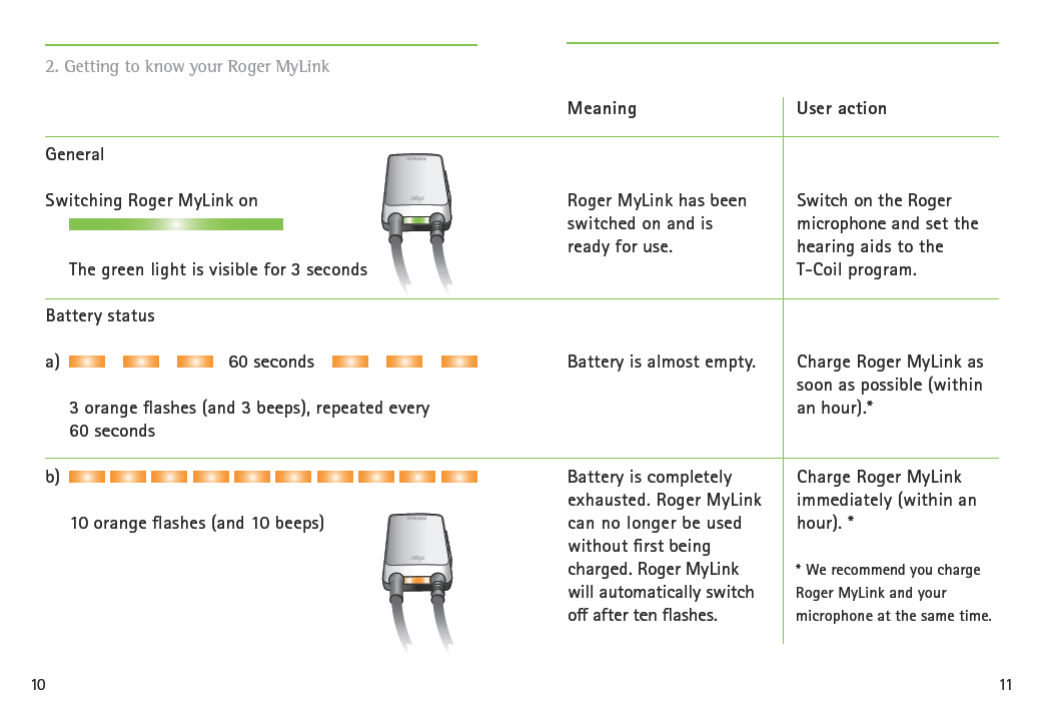
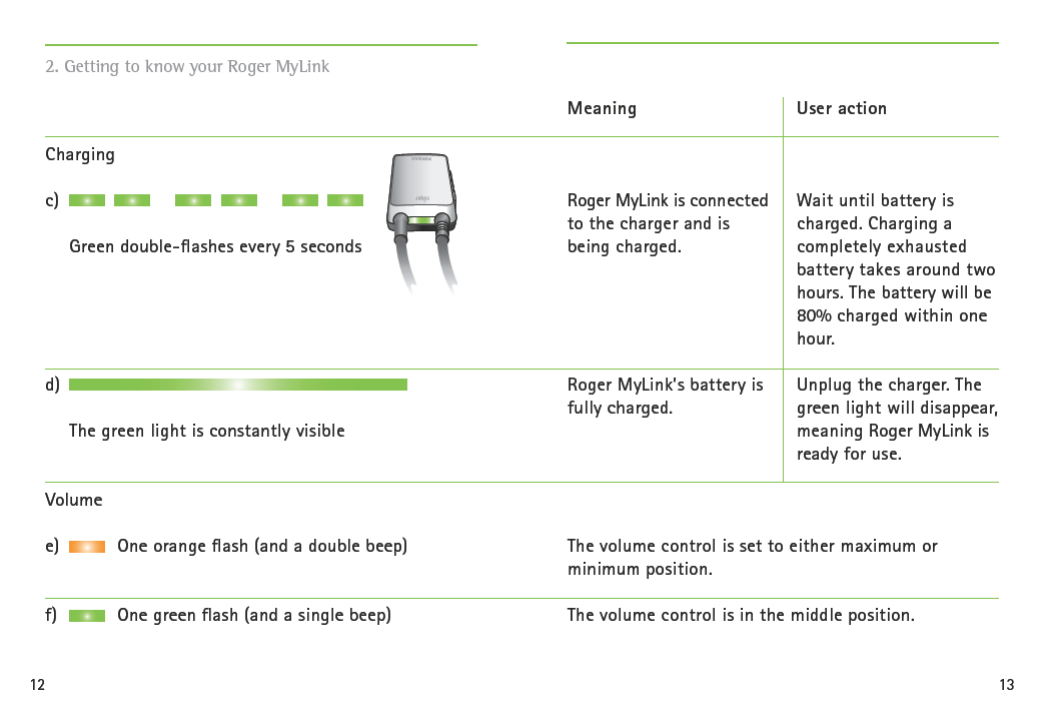
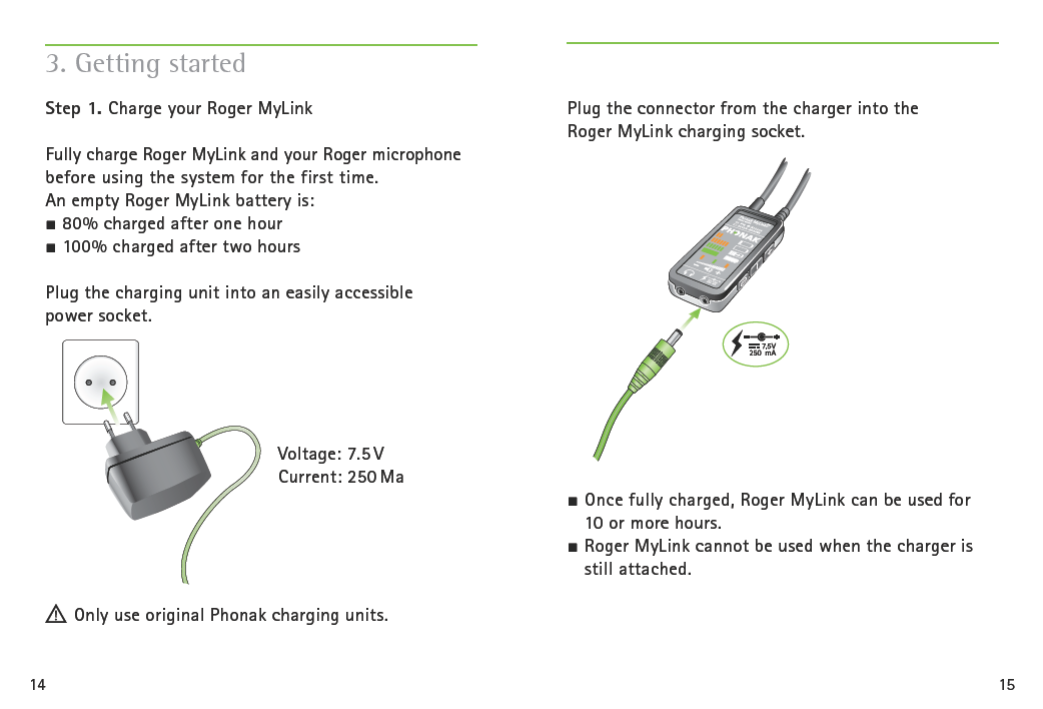
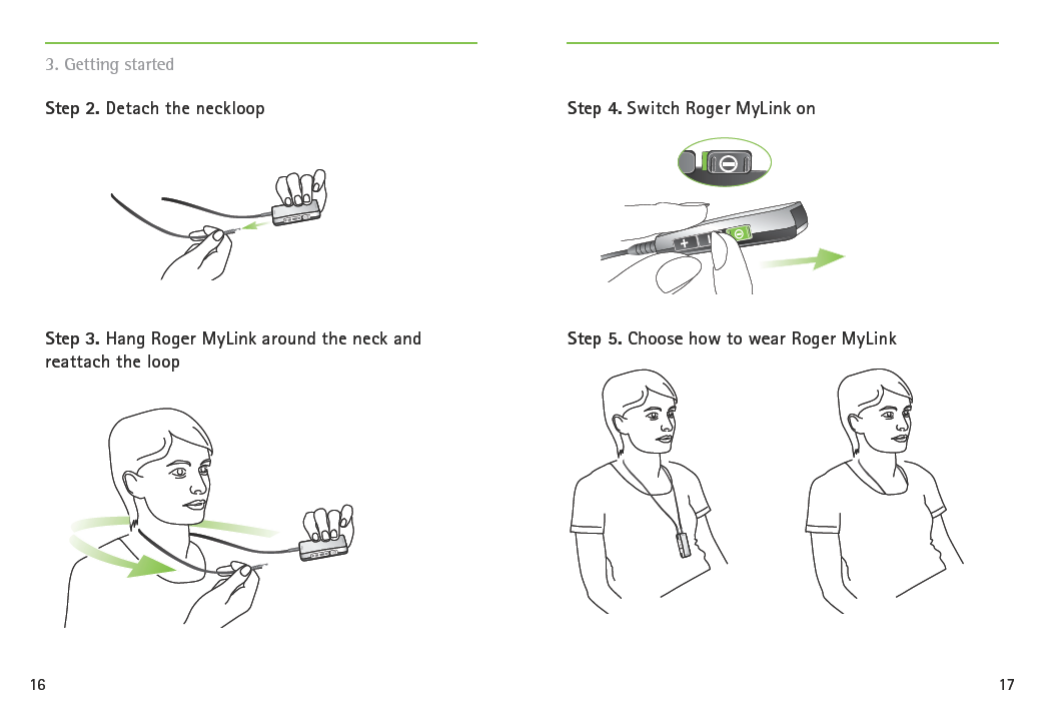

18 19
3. Getting started
Step 6. Turn on your Roger microphone
Step 7. Switch your hearing aids to the T-Coil program
It may be necessary to contact your hearing care
professional to enable the T-Coil program in your
hearing aids.
Step 8. Connect Roger MyLink to your Roger microphone
Hold Roger MyLink within 10 cm / 4 inches of your
Roger microphone and press Connect on the Roger
microphone.
Step 8 is only required the first time you use
Roger MyLink. Roger MyLink will then remain
connected with your microphone even after
Roger MyLink has been rebooted.
Ready!
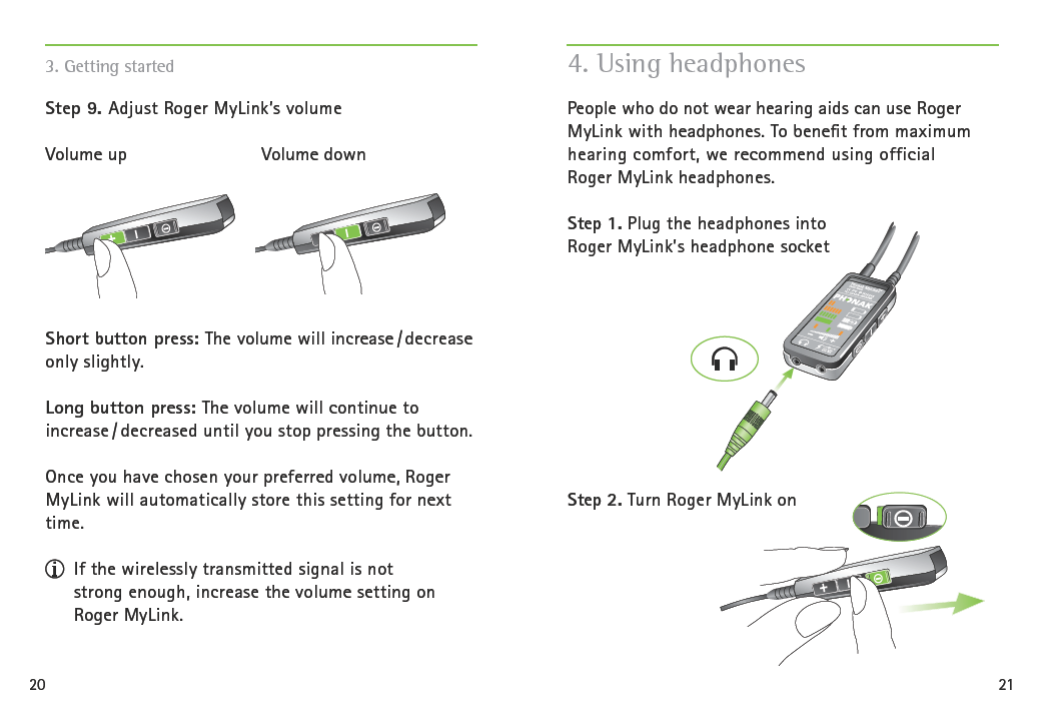
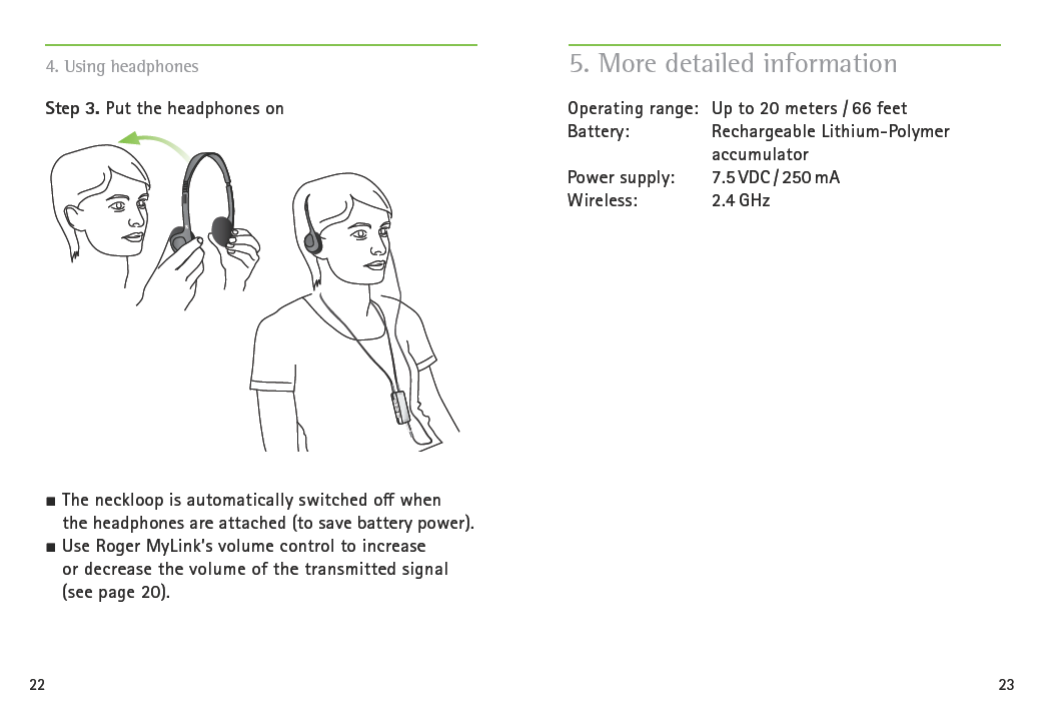

24 25
The following is a summary of frequently asked questions
about Roger MyLink and our answers to them.
Most probable cause
The green light is not visible when Roger MyLink is switched on
J Battery is completely
exhausted
I cannot hear sound from the Roger microphone
J One or all devices are
switched o
J The T-Coil is not activated
J Roger MyLink is not connected
to your Roger microphone
J The Roger microphone is muted
J Roger MyLink is out of range
of the Roger microphone
6. Troubleshooting
Solution
J Charge Roger MyLink
J Make sure all devices (Roger
MyLink, Roger microphone,
hearing aids) are turned on
and fully operational
J Switch your hearing aids to
the T-Coil program
J Connect Roger MyLink with
your Roger microphone by
pressing ‘Connect’ on your
microphone. Note that Roger
MyLink needs to be within
10cm/4 inches of your Roger
microphone
J Unmute the Roger microphone
(refer to its User Guide)
J Move closer to the Roger
microphone to move within
its operating range
The signal is interrupted during audio streaming
J Roger MyLink is too far away
from the Roger microphone
J Roger MyLink is shielded by an
obstacle (e.g. human body)
The sound of Roger MyLink is bad
J Electromagnetic fields from
other equipment may create
an audible hum through the
T-Coil of your hearing aids
J Roger microphone is not worn
correctly
The volume is too loud or too soft
J Volume is not correctly set
J Move closer to the Roger
microphone to move within
its operating range
J Adjust the device orientation
and make sure you are in
line of sight to the Roger
microphone
J Move away from electronic
equipment until the hum
stops
J Make sure the Roger
microphone is worn as
indicated in its User Guide
J Adjust the volume on Roger
MyLink until it suits your
preference
Most probable cause Solution
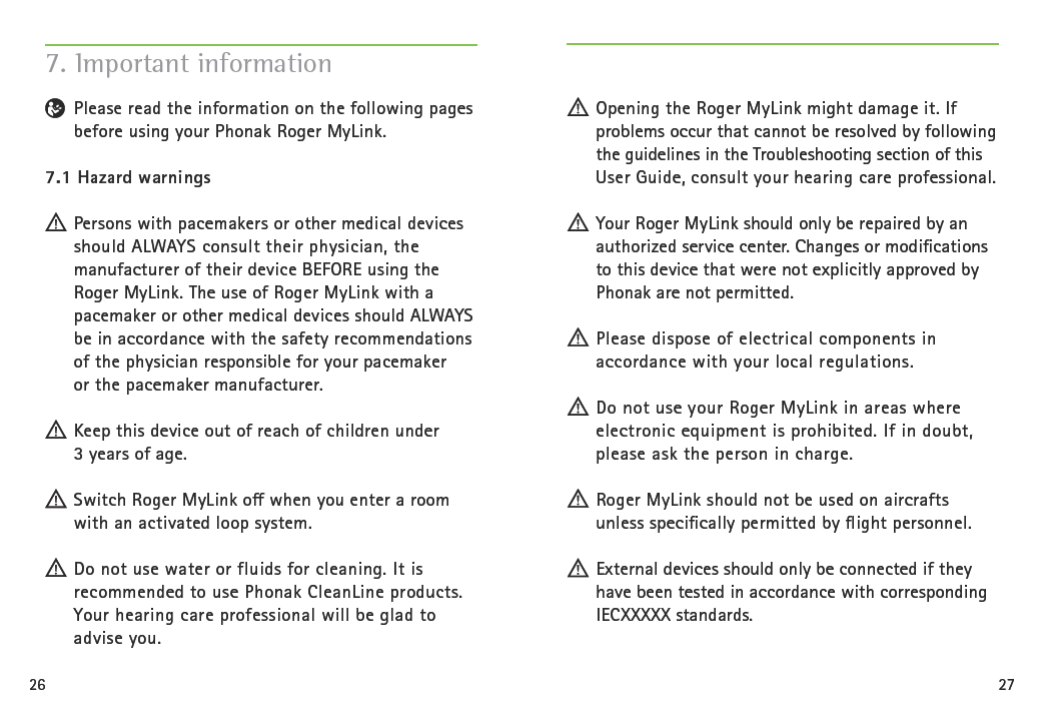

28 29
7. Important information
Only use accessories that are approved by Phonak AG.
When operating machinery, ensure that no parts of
your Roger MyLink can get caught in the machine.
Do not charge Roger MyLink while it is on your body.
7.2 Product safety information
Protect the Roger MyLink from excessive moisture
(bathing, swimming), heat (radiator, car dashboard),
and direct contact with skin when sweating
(workout, fitness, sport).
X-ray radiation, CT or MRI scans may destroy or
adversely affect the correct functioning of the
Roger MyLink.
Protect the Roger MyLink from excessive shock and
vibration.
Do not expose your Roger MyLink to temperatures
and humidity outside of the recommended conditions
stated in this User Guide.
Do not use excessive force when connecting your
Roger MyLink to its dierent cables.
Protect all openings (microphones, audio input and
charger) from dirt and debris.
If the Roger MyLink has been dropped or damaged,
if it overheats during charging, has a damaged
cord or plug, or has been dropped into liquid, stop
using your Roger MyLink and contact your hearing
care professional.
Never use a microwave or other heating devices to
dry the Roger MyLink.
Clean the Roger MyLink using a damp cloth. Never
use household cleaning products (washing powder,
soap, etc.) or alcohol to clean the Roger MyLink.
Only recharge your Roger MyLink using chargers
supplied by Phonak or by stabilized chargers
providing 7.5 VDC and ≥250 mA.

30 31
7. Important information
When the Roger MyLink is not in use, turn it o
and store it safely.
The Roger MyLink has a built-in rechargeable battery.
This battery can be charged and discharged
hundreds of times but may eventually wear out. The
battery may then only be replaced by authorized
personnel.
7.3 Other important information
J High-powered electronic equipment, larger electronic
installations and metallic structures may impair and
significantly reduce the Roger MyLink’s operating
range.
J Roger MyLink collects and stores internal technical
data. This data may be read by a hearing care
professional in order to check the device, as well as to
help you use your device correctly.
J The digital signal sent from the Roger microphone
to a connected receiver cannot be overheard by
other devices which are not in the transmitter’s
network.
J Be aware that wireless transmission from transmitter
to receiver may be interrupted due to interference
or moving out of range, and that words which are
then spoken by the transmitter wearer may not be
heard by the receiver wearer.

32 33
7. Important information
J Avoid exposing the receiver to hair spray or other
cosmetic chemicals.
J The sensitivity of the hearing aid microphone may be
reduced by the use of your Roger MyLink and therefore
environmental awareness may be reduced.
7.4 International use
J The Roger MyLink is operating in the 2.4GHz ISM
Band, which is unlicensed and worldwide available.
8. Service and warranty
8.1 Local warranty
Please ask the hearing care professional, where you
purchased your Roger MyLink, about the terms of the
local warranty.
8.2 International warranty
Phonak oers a one year limited international warranty,
valid as of the date of purchase. This limited warranty
covers manufacturing and material defects. The warranty
is valid only if proof of purchase is shown.
The international warranty does not aect any legal
rights that you might have under applicable national
legislation governing sale of consumer goods.
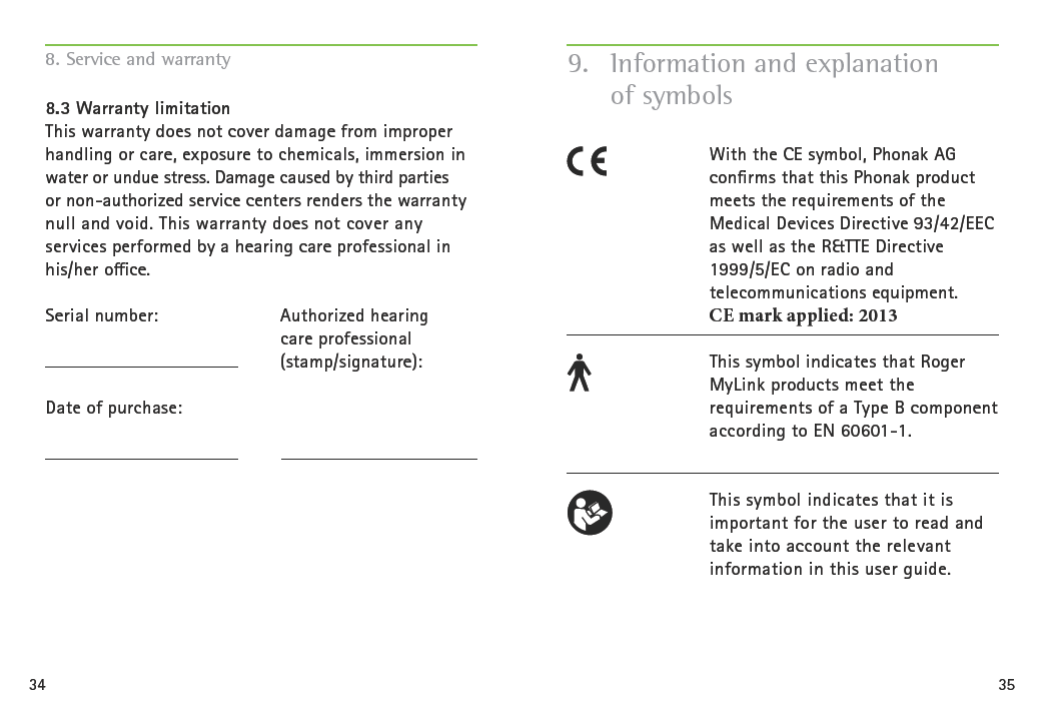
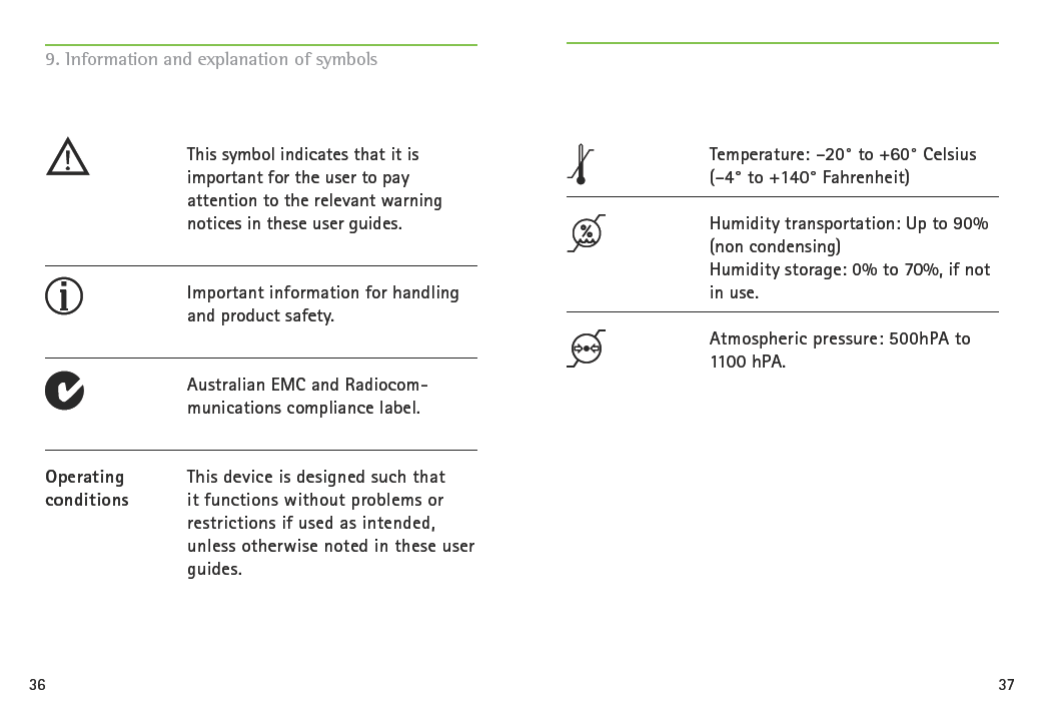

38
The symbol with the crossed-out
garbage bin is to make you aware
that this device may not be thrown
away as normal household waste.
Please dispose of old or unused device,
at waste disposal sites intended for
electronic waste, or give your device
to your hearing care professional
for disposal. Proper disposal protects
the environment and health.
This product has an embedded, non-
replaceable battery. Do not attempt
to open the product or remove the
battery as this may cause injury and
damage the product.
Please contact the local recycling
facility for removal of the battery.
9. Information and explanation of symbols
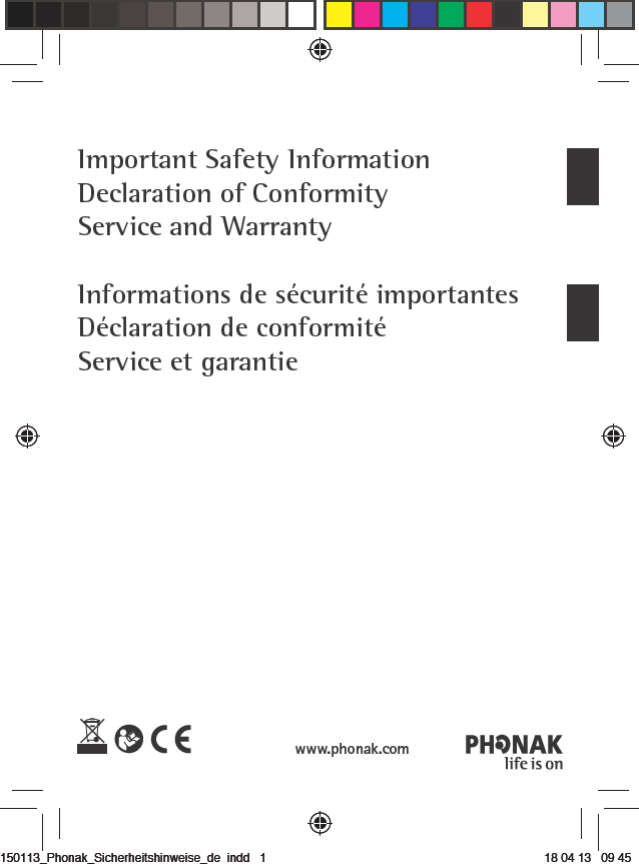

2
Content
Section 1.0 All devices, tous les appareils
Section 2.0 Roger microphone/transmitter, microphone/émetteur
Section 3.0 Roger + FM microphone/transmitter, microphone/émetteur
Section 4.0 Roger receiver, récepteur
Section 5.0 Roger SoundField loudspeaker, haut-parleurs
Section 6.0 Service and Warranty, Service et Garantie
Devices, appareils:
Roger microphone/transmitter, microphone/émetteur
Roger WallPilot
Roger + FM microphone/transmitter, microphone/émetteur
Roger inspiro
Roger DynaMic
Roger AudioHub
Roger receiver, récepteur
Roger MyLink, Roger 10, Roger 11, Roger 13, Roger 15, Roger 16, Roger X, Roger receiver
Guide-U
Roger SoundField loudspeaker, haut-parleurs
Roger DigiMaster 5000
Roger DigiMaster 7000
Roger DigiMaster X
The information contained herein is subject to change without notice.
Les informations ci-dessous peuvent faire l’objet de modifications sans notification préalable.
150113_Phonak_Sicherheitshinweise_de indd 2 18 04 13 09 45
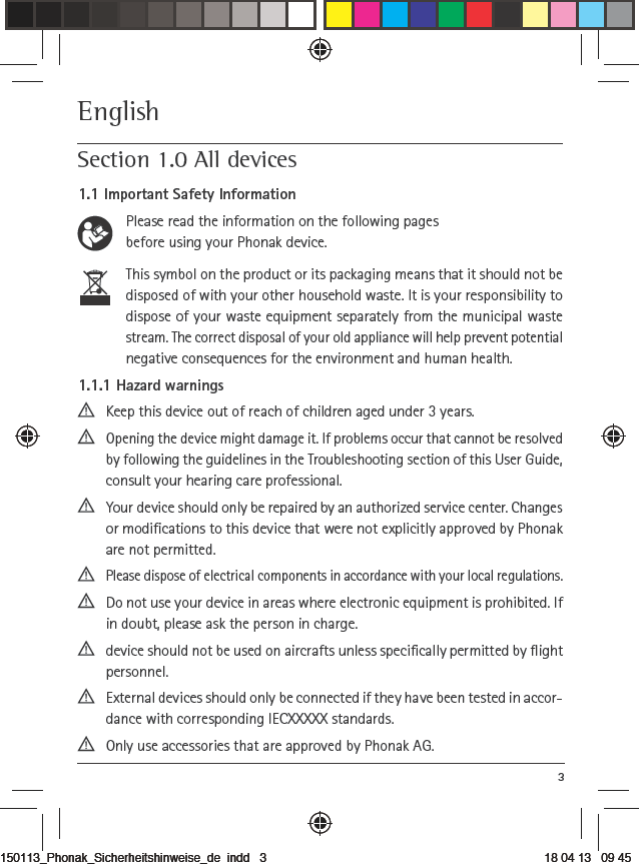

4
1.1.2 Product safety information
i
Protect the device from excessive shock and vibration.
i
Do not expose your device to temperatures and humidity outside
of the
recommended conditions stated in this User Guide.
i
Never use a microwave or other heating devices to dry the device.
i
Clean the device using a damp cloth. Never use household cleaning products
(washing powder, soap, etc.) or alcohol to clean the device.
i
Only recharge your device using chargers supplied by Phonak or by stabilized
chargers providing 5VDC and ≥500 mA.
i
Do not connect an USB or audio cable to your device that exceeds 3 meters
(9ft) in length.
i
When the device is not in use, turn it OFF and store it safely.
1.1.3 Other important information
Persons with pacemakers or other medical devices should ALWAYS
consult
their physician, the manufacturer of their device BEFORE using the device. The
use of the device with a pacemaker or other medical devices should ALWAYS
be in accordance with the safety recommendations of the physician responsible
for your pacemaker
or the pacemaker manufacturer.
1.2 Declaration of Conformity
For the devices used in body worn operation, the devices have been tested and
found in compliance with the requirements of EN 62209-2, FCC rule paragraph
2.1093, the ANSI/IEEE C95.1:1999, the NCRP Report Number 86 for uncontrolled
environment, according
to the Health Canada’s Safety Code 6 and the Industry
Canada Radio
Standards Specification RSS-102 for General Population/Uncon-
trolled
exposure.
For the devices, which are not intended to be used in body worn operation, the
antenna(s) used for these devices must be installed to provide a separation distance
150113_Phonak_Sicherheitshinweise_de indd 4 18 04 13 09 45
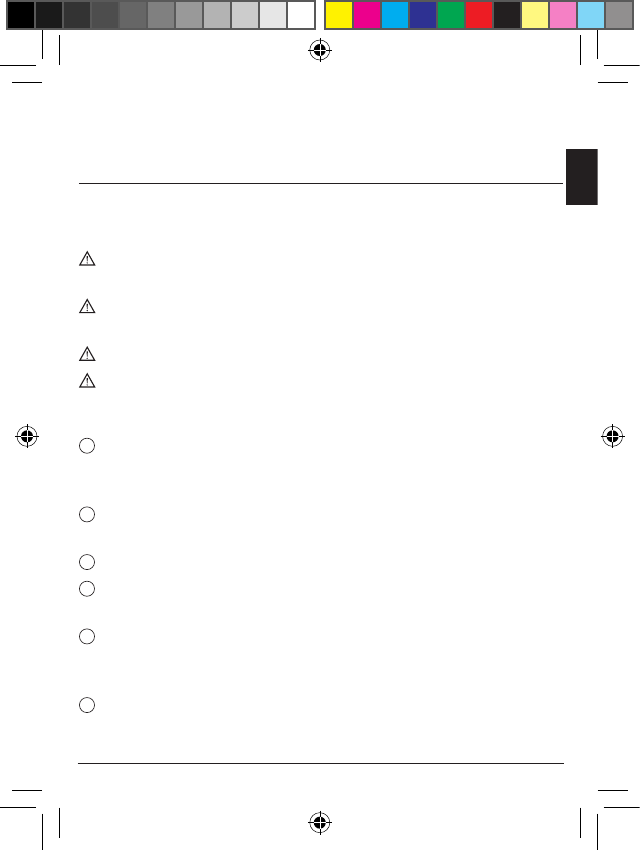
5
of at least 20 cm from all persons and must not be collocated or operating in
conjunction with any other antenna or transmitter to comply with FCC and Industry
Canada RF exposure limits for general population/uncontrolled exposure.
Section 2.0 Roger microphone/transmitter
2.1 Hazard warnings
Using your device’s cables in any way contradictory to their intended purpose
(e. g., wearing the USB cable around the neck) can cause injury.
When operating machinery, ensure that no parts of your device can get
caught
in the machine.
Do not charge device while it is on your body.
Caution: electric shock. Do not insert plug alone into electrical outlets.
2.1.1 Product safety information
i
Protect the device from excessive moisture (bathing, swimming), heat (radi-
ator,
car dashboard), and direct contact with skin when sweating (workout,
fitness, sport).
i
X-ray radiation, CT or MRI scans may destroy or adversely aect the correct
functioning of the device.
i
Do not use excessive force when connecting your device to its dierent cables.
i
Protect all openings (microphones, audio input and charger) from dirt and
debris.
i
If the device has been dropped or damaged, if it overheats during charging,
has a damaged cord or plug, or has been dropped into liquid, stop using
your device and contact your hearing care professional.
i
The device has a built-in rechargeable battery. This battery can be charged
and discharged hundreds of times but may eventually wear out. The battery
may then only be replaced by authorized personnel.
150113_Phonak_Sicherheitshinweise_de indd 5 18 04 13 09 45

6
2.1.2 Other important information
Device collects and stores internal technical data. This data may
be read by a
hearing care professional in order to check the device,
as well as to help you
use your device correctly.
The digital signal sent from the device to a connected receiver cannot be
overheard by other devices which are not in the microphone’s network.
2.2 Declaration of Conformity
Hereby, Phonak Communications AG, Länggasse 17, CH-3280 Murten,
declares
that these Phonak products are in compliance with the essential requirements
and other relevant provisions of Directive 1999/5/EC. To obtain a copy of the
Declaration of conformity, please contact the manufacturer or the local Phonak
representative whose address can be taken from the list on www.phonak.com
(worldwide locations).
This device complies with Part 15 of the FCC Rules and with RSS210 of Industry
Canada. Operation is subject to the following two conditions: (1) This device may
not cause harmful interference, and (2) this device must accept any interference
received, including interference that may cause undesired operation. The device
has been tested and found to comply with the limits for a Class B digital device,
pursuant to Part 15 of the FCC Rules. These limits are designed to provide rea-
sonable protection against harmful interference in a residential installation. The
device generates uses and can radiate radio frequency energy and, if not installed
and used in accordance with the instructions, may cause harmful interference to
radio communications. However, there is no guarantee that interference
will
not
occur in a particular installation. If the device does cause harmful interference
to
radio or television reception, which can be determined by turning the device o
and on, the user is encouraged to try to correct the interference by one of the
following measures:
– Reorient or relocate the receiving antenna.
– Increase the separation between the device and receiver.
150113_Phonak_Sicherheitshinweise_de indd 6 18 04 13 09 45
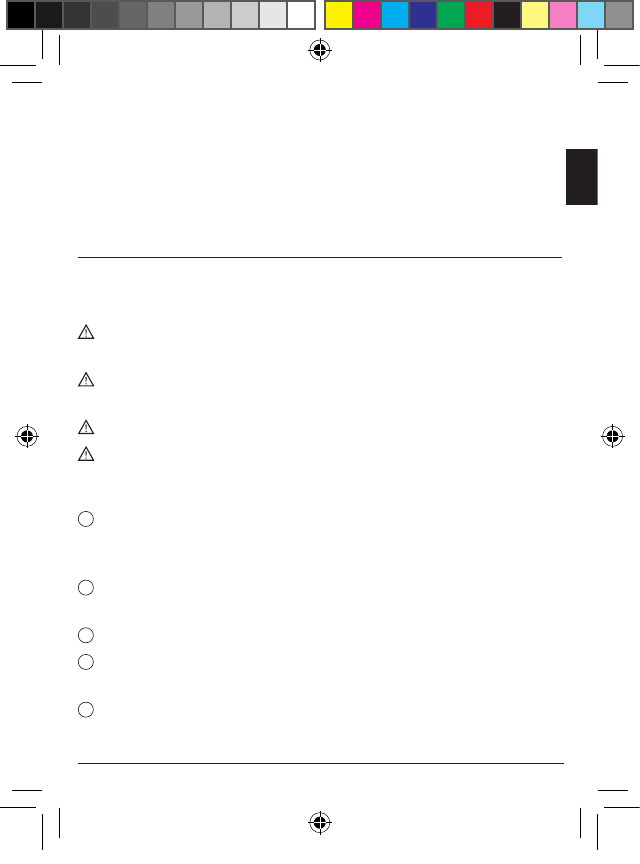
7
– Connect the device into an outlet on a circuit dierent from that to which the
receiver is connected.
– Consult the dealer or an experienced radio/TV technician for help.
FCC Caution: Any changes or modifications not expressly approved by the
party responsible for compliance could void the user’s authority to operate
the device.
Section 3.0 Roger + FM microphone/transmitter
3.1. Hazard warnings
Using your device’s cables in any way contradictory to their intended purpose
(e. g., wearing the USB cable around the neck) can cause injury.
When operating machinery, ensure that no parts of your device can get caught
in the machine.
Do not charge device while it is on your body.
Caution: electric shock. Do not insert plug alone into electrical outlets.
3.1.1 Product safety information
i
Protect the device from excessive moisture (bathing, swimming), heat (radiator,
car dashboard), and direct contact with skin when sweating (workout, fitness,
sport).
i
X-ray radiation, CT or MRI scans may destroy or adversely aect the correct
functioning of the device.
i
Do not use excessive force when connecting your device to its dierent cables.
i
Protect all openings (microphones, audio input and charger) from dirt and
debris.
i
If the device has been dropped or damaged, if it overheats during charging,
has a damaged cord or plug, or has been dropped into liquid, stop using
your device and contact your hearing care professional.
150113_Phonak_Sicherheitshinweise_de indd 7 18 04 13 09 45

8
i
The device has a built-in rechargeable battery. This battery can be charged
and discharged hundreds of times but may eventually wear out. The battery
may then only be replaced by authorized personnel.
3.1.2 Other important information
Device collects and stores internal technical data. This data may be read by a
hearing care professional in order to check the device, as well as to help you
use your device correctly.
Your device is approved to operate at a radio frequency that is specific to your
country or region and might not be approved for use outside your country or
region. Be aware that operation during international travel may cause inter-
ference with other electronic devices, or other electronic devices may cause
interference with your device.
Be aware that your device’s FM radio signals might also be picked up and
overheard by other FM receivers.
3.2 Declaration of Conformity
Hereby, Phonak Communications AG, Länggasse 17, CH-3280 Murten,
declares
that these Phonak products are in compliance with the essential requirements
and other relevant provisions of Directive 1999/5/EC. To obtain a copy of the
Declaration of conformity, please contact the manufacturer or the local Phonak
representative whose address can be taken from the list on www.phonak.com
(worldwide locations).
This device complies with Part 15 and part 95 of the FCC Rules and with RSS210
of Industry Canada. Operation is subject to the following two conditions: (1) This
device may not cause harmful
interference, and (2) this device must accept any
interference received,
including interference that may cause undesired operation.
The device has been tested and found to comply with the limits for a Class B
digital device, pursuant to Part 15 of the FCC Rules. These
limits are designed to
provide reasonable protection against harmful
interference in a residential instal-
lation. The device generates uses and can radiate radio frequency energy and, if
150113_Phonak_Sicherheitshinweise_de indd 8 18 04 13 09 45

9
not installed and used in accordance with the instructions, may cause harmful
interference to radio communications. However, there is no guarantee that in-
terference will not occur in a particular installation. If the device does cause
harmful interference to radio or television reception, which can be determined
by turning the device o and on, the user is encouraged to try to correct the
interference by one of the following measures:
– Reorient or relocate the receiving antenna.
– Increase the separation between the device and receiver.
– Connect the device into an outlet on a circuit dierent from that to which the
receiver is connected.
– Consult the dealer or an experienced radio/TV technician for help.
FCC Caution: Any changes or modifications not expressly approved
by the
party responsible for compliance could void the user’s authority to operate
the device.
This transmitter is authorized by rule under the Low Power Radio Service (47 CFR
part 95) and must not cause harmful interference to TV reception or United
States Navy SPASUR installations. You do not need an FCC license to operate this
transmitter. This transmitter may only be used to provide: auditory assistance to
persons with disabilities, persons who require language translation, or persons
in educational settings; health care services to the ill; law enforcement
tracking
services under agreement with a law enforcement agency; or automated maritime
telecommunications system (AMTS) network
control communications.
Two way voice communications and all other types of uses not
mentioned above are
expressly prohibited. This device may not interfere
with TV reception or Federal
Government radar. For Canada: if TV channel 13 is used in the area, the installer
shall reduce or adjust the radio frequency radiated power so that nearby TV channel
13 receivers do not receive radio interference from the system installed. Sugges-
tions:
A test with a TV receiver equipped with a “rabbit-ear antenna” and tuned to
channel 13 should be conducted at the perimeter of the user’s intended coverage
150113_Phonak_Sicherheitshinweise_de indd 9 18 04 13 09 45

10
area and should not overlap other users’ areas without the latter’s consent. If this
does not solve the problem, a channel near the 217 MHz edge and not near 216 MHz
should be tried. This Class B digital apparatus complies with Canadian ICES-003.
Section 4.0 Roger receivers
4.1 Product safety information
i
Protect the device from excessive moisture (bathing, swimming), heat (radiator,
car dashboard), and direct contact with skin when sweating (workout, fitness,
sport).
i
X-ray radiation, CT or MRI scans may destroy or adversely aect the correct
functioning of the device.
4.1.1 Other important information
The digital signal sent from the device to a connected receiver cannot be over-
heard by other devices which are not in the microphone’s network.
Be aware that wireless transmission from microphone to receiver may be inter-
rupted due to interference or moving out of range, and that words which are
then spoken by the microphone wearer may not be heard by the receiver wearer.
Avoid exposing the receiver to hair spray or other cosmetic chemicals.
The sensitivity of the hearing aid microphone may be reduced by the use of
your device and therefore environmental awareness may be reduced.
Universal receivers may sound a loud beep at start-up, which might be annoying
for cochlear implant users. Please contact your hearing care professional to discuss
deactivating this beep function.
4.2 Declaration of Conformity
Roger receivers are products of Phonak AG, which have been tested and confirmed
to be in compliance with the essential requirements and other relevant provisions
of the Medical Devices Directive 93/42/EEC and Directive 1999/5/EC. To obtain a copy
150113_Phonak_Sicherheitshinweise_de indd 10 18 04 13 09 45

11
of the Declaration of conformity, please contact the manufacturer or the local
Phonak representative whose address can be taken from the list on www.phonak.com
(worldwide locations).
This device complies with Part 15 of the FCC Rules and with RSS210 of Industry
Canada. Operation is subject to the following two conditions: (1) This device may
not cause harmful interference, and (2) this device must accept any interference
received, including interference that may cause undesired operation. The device
has been
tested and found to comply with the limits for a Class B digital device,
pursuant to Part 15 of the FCC Rules. These limits are designed to provide rea-
sonable protection against harmful interference in a residential installation. The
device generates uses and can radiate radio frequency energy and, if not installed
and used in accordance with the instructions, may cause harmful interference to
radio communications. However, there is no guarantee that interference will not
occur in a particular installation. If the device does cause harmful interference
to radio or television reception, which can be determined by turning the device
o and on, the user is encouraged to try to correct the interference by one of the
following measures:
– Reorient or relocate the receiving antenna.
– Increase the separation between the device and receiver.
– Connect the device into an outlet on a circuit dierent from that to which the
receiver is connected.
– Consult the dealer or an experienced radio/TV technician for help.
FCC Caution: Any changes or modifications not expressly approved by the
party responsible for compliance could void the user’s authority to operate
the device.
150113_Phonak_Sicherheitshinweise_de indd 11 18 04 13 09 45

12
Section 5.0 Roger SoundField loudspeaker
5.1 Other important information
The digital signal sent from the device to a connected receiver cannot be over-
heard by other devices which are not in the microphone’s network.
5.2 Declaration of Conformity
Hereby, Phonak Communications AG, Länggasse 17, CH-3280 Murten, declares that
these Phonak products are in compliance with the essential requirements and other
relevant provisions of Directive 1999/5/EC. To obtain a copy of the Declaration of
conformity, please contact the manufacturer or the local Phonak representative
whose address can be taken from the list on www.phonak.com (worldwide locations).
This device complies with Part 15 of the FCC Rules and with RSS210 of Industry
Canada. Operation is subject to the following two conditions: (1) This device may
not cause harmful interference, and (2) this device must accept any interference
received, including interference that may cause undesired operation. This device has
been tested and found to comply with the limits for a Class B digital device, pursu-
ant to Part 15 of the FCC Rules. These limits are designed to provide reasonable
protection against harmful interference in a residential installation. The device gen-
erates uses and can radiate radio frequency energy and, if not installed and used in
accordance with the instructions, may cause harmful interference to radio commu-
nications. However, there is no guarantee that interference will not occur in a par-
ticular installation. If the device does cause harmful interference to radio or televi-
sion reception, which can be determined by turning the device o and on, the user
is encouraged to try to correct the interference by one of the following measures:
– Reorient or relocate the receiving antenna.
– Increase the separation between the device and receiver.
– Connect the device into an outlet on a circuit dierent from that to which the
receiver is connected.
– Consult the dealer or an experienced radio/TV technician for help.
150113_Phonak_Sicherheitshinweise_de indd 12 18 04 13 09 45

13
FCC Caution: Any changes or modifications not expressly ap proved by the
party responsible for compliance could void the user’s authority to operate
the device.
6.0 Service and Warranty
Local warranty
Please ask the hearing care professional, where you purchased your device,
about the terms of the local warranty.
International warranty
Phonak oers a one year limited international warranty, valid as of the date of
purchase. This limited warranty covers manufacturing and material defects. The
warranty is valid only if proof of purchase is shown.
Warranty limitation
This warranty does not cover damage from improper handling or care, exposure
to chemicals, immersion in water or undue stress. Damage caused by third parties
or non-authorized service centers renders the warranty null and void. This warranty
does not cover any services performed by a hearing care professional in his/her
oce.
Serial number:
Purchase date:
Authorized hearing
care professional
(stamp/signature):
150113_Phonak_Sicherheitshinweise_de indd 13 18 04 13 09 45
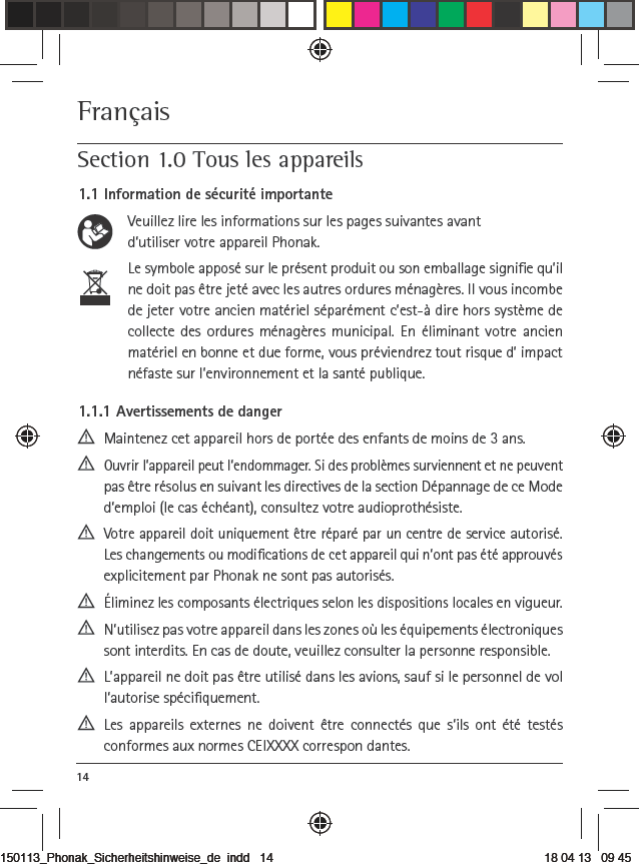
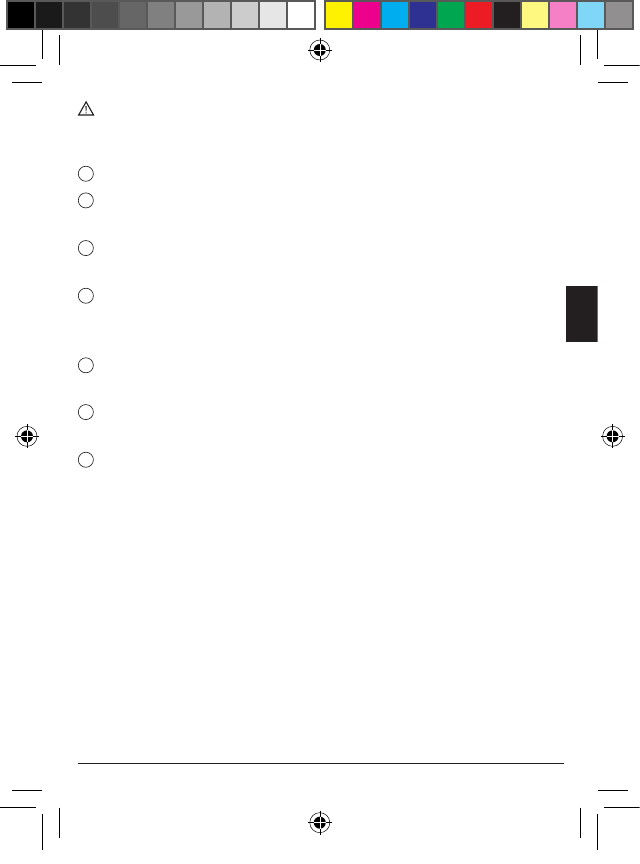
15
N’utilisez que des accessoires approuvés par Phonak AG.
1.1.2 Informations sur la sécurité du produit
i
Protégez l’appareil des chocs et vibrations excessifs.
i
N’exposez pas votre appareil à des températures et une humidité
hors des
conditions recommandées dans le présent Mode d’emploi.
i
N’utilisez jamais de four à micro-ondes ou d’autres appareils de chauage
pour sécher l’appareil.
i
Nettoyez l’appareil avec un chion humide. N’utilisez jamais de produits de
nettoyage domestiques (lessive en poudre, savon, etc.) ou d’alcool pour net-
toyer l’appareil.
i
Ne rechargez votre appareil qu’avec les chargeurs fournis par
Phonak ou des
chargeurs stabilisés fournissant 5 VCC et ≥ 500 mA.
i
Ne connectez pas de câble USB ou audio de plus de 3 mètres de long à votre
appareil.
i
Quand l’appareil n’est pas utilisé, éteignez-le et conservez-le en lieu sûr.
1.1.3 Autres informations importantes
Les personnes portant un stimulateur cardiaque ou d’autres appareils médicaux
doivent TOUJOURS consulter leur médecin ou le fabricant de leur appareil
AVANT
d’utiliser l’appareil. L’utilisation
de l’appareil avec un stimulateur cardiaque ou
d’autres appareils médicaux doit TOUJOURS être conforme aux recommandations
de sécurité du médecin responsable de votre stimulateur cardiaque
ou du fabri-
cant du stimulateur cardiaque.
1.2 Déclaration de Conformité
Pour l’utilisation sur le corps, cet appareil a été jugé conforme aux exigences
d’EN 62209-2, Réglementation de la FCC paragraphe 2.1093, l’ANSI/IEEE C95.1:1999,
le rapport numéro 86 du NCRP pour l’environnement non contrôlé, conformément
150113_Phonak_Sicherheitshinweise_de indd 15 18 04 13 09 45
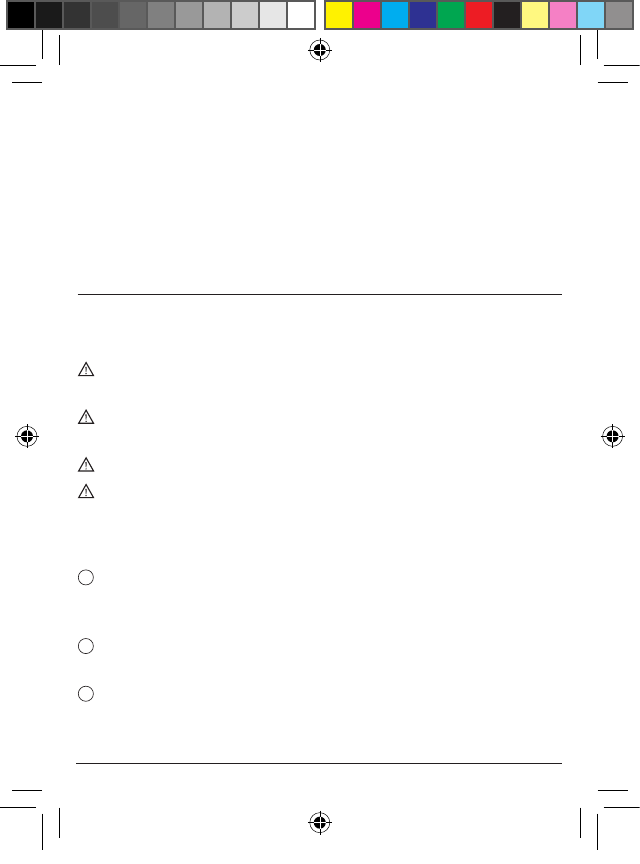
16
au code de sécurité 6 de Santé Canada et la norme radio CNR-102
d’Industrie
Canada pour l’exposition non contrôlée/de la population en général.
Appareil non porté sur le corps (le cas échéant) : À des fins de con
formité avec
les limites d’exposition RF de la FCC et Industrie Canada
pour l’exposition non
contrôlée/de la population en général, les antenne(s) utilisée(s) pour ce trans-
metteur doivent être installées de manière à fournir une distance de séparation
d’au moins 20 cm avec toutes les personnes et ne doivent pas être rassemblées
ou
fonctionner en conjonction avec toute autre antenne ou tout émetteur.
Section 2.0 Roger microphone/émetteur
2.1 Avertissements de danger
Utiliser les câbles de votre appareil de manière contraire à leur usage prévu
(par ex. porter le câble USB autour du cou) peut provoquer des blessures
Lors de l’utilisation de machines, assurez-vous qu’aucune partie de votre
appareil ne puisse se coincer dans la machine.
Ne chargez pas l’appareil lorsqu’il est sur votre corps.
Avertissement : électrocution. N’insérez pas la fiche seule dans des prises
électriques.
2.1.1 Informations sur la sécurité du produit
i
Protégez l’appareil contre l’humidité excessive (bain, natation), la chaleur
(radiateur,
tableau de bord de voiture) et le contact direct
avec la peau lorsque
vous transpirez (musculation, exercice, sport).
i
Les radiographies, tomodensitométries ou IRM peuvent détruire
ou avoir un
impact négatif sur le bon fonctionnement de l’appareil.
i
N’exercez pas de force excessive lors de la connexion de votre appareil à ses
diérents câbles.
150113_Phonak_Sicherheitshinweise_de indd 16 18 04 13 09 45
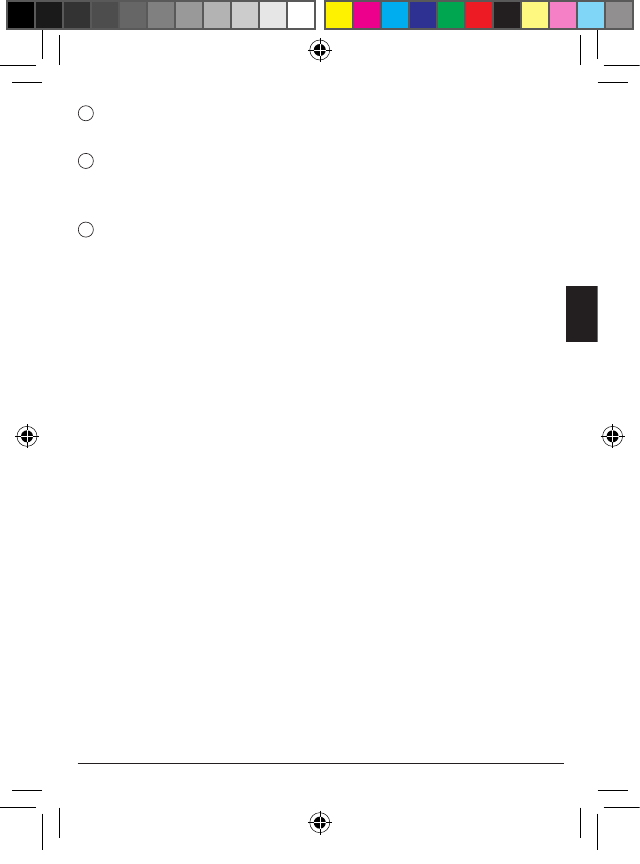
17
i
Protégez toutes les ouvertures (microphones, entrée audio et chargeur) de la
saleté et des impuretés.
i
Si l’appareil est tombé ou a été endommagé, s’il surchaue pendant
le char-
gement, si son cordon ou sa fiche est endommagé ou s’il est tombé dans un
liquide, arrêtez de l’utiliser et contactez votre audioprothésiste.
i
L’appareil a une pile rechargeable intégrée. Celle-ci peut être chargée et
déchargée des centaines de fois mais peut finir par
s’user. La pile ne peut
être remplacée que par un personnel autorisé.
2.1.2 Autres informations importantes
L’appareil recueille et stocke les données techniques internes. Ces
données
peuvent être lues par un audioprothésiste afin de contrôler
l’appareil et de vous
aider à l’utiliser correctement.
Le signal numérique envoyé par l’émetteur de l’appareil au récepteur
connecté
ne peut pas être entendu par d’autres appareils non intégrés au réseau de
l’émetteur.
2.2 Déclaration de Conformité
Par la présente, Phonak Communications AG, Länggasse 17, CH-3280 Murten,
déclare que le produit Phonak est conforme aux
exigences principales et autres
dispositions pertinentes de la directive
1999/5/CE. Pour obtenir une copie de la
Déclaration de conformité, veuillez contacter le fabricant ou le représentant
Phonak local dont l’adresse figure sur la liste du site www.phonak.com (sites à
travers le monde).
Cet appareil est conforme aux sections 15 des réglements de la FCC et à CNR-210
d’Industrie Canada. Le fonctionnement aux deux conditions suivantes : (1) Cet
appareil ne doit pas provoquer d’interférences gênantes et (2) l’utilisateur de cet
appareil doit accepter les interférences reçues, y compris les interférences pouvant
provoquer un fonctionnement non désiré. Cet équipement a été testé et jugé en
conformité avec les limites aérentes à un appareil numérique de classe B, en
150113_Phonak_Sicherheitshinweise_de indd 17 18 04 13 09 45

18
vertu de la section 15 des règlements de la FCC. Ces
normes sont conçues pour
assurer une protection raisonnable contre
les interférences nuisibles dans un en-
vironnement résidentiel. Cet appareil génère, utilise et peut émettre de l’énergie
radioélectrique et, s’il n’est pas installé ou utilisé selon les directives, peut causer
des interférences nuisibles aux communications radio. Cependant, il n’existe au-
cune garantie que des interférences ne se produiront pas dans une installation
particulière. Si cet appareil est la source d’interférences nuisibles pour la réception
des ondes de radio ou de télévision, ce qui peut être déterminé en mettant l’appareil
hors tension, puis sous tension, il est recommandé de tenter
d’éliminer ces inter-
férences en appliquant l’une ou plusieurs des mesures suivantes :
– Réorienter ou déplacer l’antenne réceptrice.
– Éloigner l’appareil du récepteur.
– Brancher l’appareil dans une prise d’un circuit diérent de celui qui alimente le
récepteur.
–
Consulter le détaillant ou un technicien radio ou télévision qualifié
pour obtenir
de l’aide.
Avertissement de la FCC : tout changement ou toute modification non
expressément approuvés par la partie responsable de la
conformité pourrait
entraîner l’annulation des droits d’utilisation
de cet appareil.
Section 3.0 Roger + FM microphone/émetteur
3.1 Avertissements de danger
Utiliser les câbles de votre appareil de manière contraire à leur usage prévu
(par ex. porter le câble USB autour du cou) peut provoquer des blessures
Lors de l’utilisation de machines, assurez-vous qu’aucune partie de votre
appareil ne puisse se coincer dans la machine.
Ne chargez pas l’appareil lorsqu’il est sur votre corps.
150113_Phonak_Sicherheitshinweise_de indd 18 18 04 13 09 45
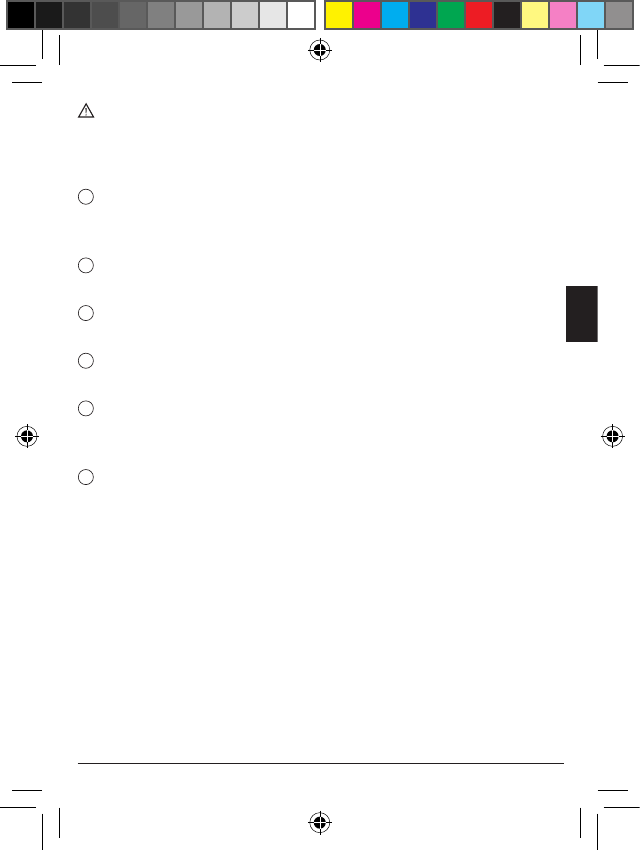
19
Avertissement : électrocution. N’insérez pas la fiche seule dans des prises
électriques.
3.1.1 Informations sur la sécurité du produit
i
Protégez l’appareil contre l’humidité excessive (bain, natation) la chaleur
(radia teur, tableau de bord de voiture) et le contact direct avec la peau
lorsque vous transpirez (musculation, exercice, sport).
i
Les radiographies, tomodensitométries ou IRM peuvent détruire
ou avoir un
impact négatif sur le bon fonctionnement de l’appareil.
i
N’exercez pas de force excessive lors de la connexion de votre appareil à ses
diérents câbles.
i
Protégez toutes les ouvertures (microphones, entrée audio et chargeur) de
la saleté et des impuretés.
i
Si l’appareil est tombé ou a été endommagé, s’il surchaue pendant le char-
gement, si son cordon ou sa fiche est endommagé ou s’il est tombé dans un
liquide, arrêtez de l’utiliser et contactez votre audioprothésiste.
i
L’appareil a une pile rechargeable intégrée. Celle-ci peut être chargée et
déchargée des centaines de fois mais peut finir par s’user. La pile ne peut
être remplacée que par un personnel autorisé.
3.1.2 Autres informations importantes
L’appareil recueille et stocke les données techniques internes. Ces
données
peuvent être lues par un audioprothésiste afin de contrôler
l’appareil et de vous
aider à l’utiliser correctement.
Votre appareil est approuvé pour un fonctionnement à une fréquence radio
spécifique à votre pays ou région et peut ne pas être approuvé pour une utilisation
en dehors de votre pays ou région. Notez que le fonctionnement au cours d’un
voy age international peut provoquer des interférences avec d’autres appareils
électroniques, ou d’autres appareils électroniques peuvent provoquer des inter-
férences avec votre appareil.
150113_Phonak_Sicherheitshinweise_de indd 19 18 04 13 09 45

20
Notez que les signaux radio FM de votre appareil peuvent aussi être détectés
et entendus par d’autres récepteurs FM.
3.2 Déclaration de Conformité
Par la présente, Phonak Communications AG, Länggasse 17, CH-3280 Murten,
déclare que le produit Phonak est conforme aux exigences principales et autres
dispositions pertinentes de la directive 1999/5/CE. Pour obtenir une copie de la
Déclaration de conformité, veuillez contacter le fabricant ou le représentant
Phonak local dont l’adresse figure sur la liste du site www.phonak.com (sites à
travers le monde).
Cet appareil est conforme aux sections 15 des réglements de la FCC et à CNR-
210 d’Industrie Canada. Le fonctionnement aux deux conditions suivantes : (1)
Cet appareil ne doit pas provoquer d’interférences gênantes et (2) l’utilisateur de
cet appareil doit accepter les interférences reçues, y compris les interférences
pouvant provoquer un fonctionnement non désiré. Cet équipement a été testé et
jugé en conformité avec les limites aérentes à un appareil numérique de classe
B, en vertu de la section 15 des règlements de la FCC. Ces normes sont conçues
pour assurer une protection raisonnable contre les interférences nuisibles dans
un environnement résidentiel. Cet appareil génère, utilise et peut émettre de
l’énergie radioélectrique et, s’il n’est pas installé ou utilisé selon les directives,
peut causer des interférences nuisibles aux communications radio. Cependant, il
n’existe aucune garantie que des interférences ne se produiront pas dans une
installation particulière. Si cet appareil est la source d’interférences nuisibles
pour la réception des ondes de radio ou de télévision, ce qui peut être déterminé
en mettant l’appareil hors tension, puis sous tension, il est recommandé de tenter
d’éliminer ces interférences en appliquant l’une ou plusieurs des mesures suivantes :
– Réorienter ou déplacer l’antenne réceptrice.
– Éloigner l’appareil du récepteur.
– Brancher l’appareil dans une prise d’un circuit diérent de celui qui alimente le
récepteur.
150113_Phonak_Sicherheitshinweise_de indd 20 18 04 13 09 45
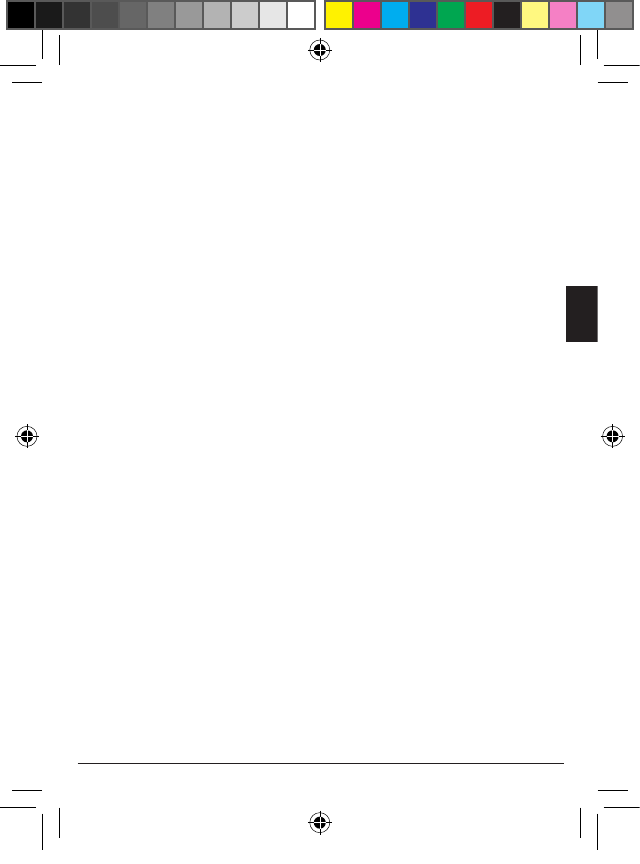
21
–
Consulter le détaillant ou un technicien radio ou télévision qualifié
pour obtenir
de l’aide.
Avertissement de la FCC : tout changement ou toute modification
non
expressément approuvés par la partie responsable de la
conformité pourrait
entraîner l’annulation des droits d’utilisation
de cet appareil.
Cet émetteur est autorisé par la réglementation du Low Power Radio
Service (47
CFR section 95) et ne doit pas provoquer d’interférences parasites sur la réception
de la télévision ou sur les installations SPASUR de l’United States Navy. Vous
n’avez pas besoin de licence FCC pour utiliser cet émetteur. Cet émetteur ne peut
être utilisé que pour fournir : une assistance auditive aux malentendants, aux
personnes qui ont besoin d’une traduction ou aux personnes travaillant dans
l’éducation ; dans des services de soins aux malades ; dans des services d’inves-
tigations chargés de faire respecter la loi, sous réserve de l’accord d’une agence
responsable ; ou dans les réseaux de contrôle des communications des systèmes
automatisés de télécommunication maritime (AMTS).
La communication orale à double sens ainsi que toutes les autres applications
non mentionnées ci-dessus sont formellement interdites. Cet appareil ne doit
pas interférer avec la réception de la télévision ou des radars du gouvernement
fédéral. Pour le Canada : si le canal 13 de la télévision est utilisée dans la zone,
l’utilisateur doit réduire ou ajuster la puissance de la fréquence radio émise afin
que les récepteurs du canal 13 de la télévision à proximité ne reçoivent pas
d’interférences radio du système installé. Suggestions : un test avec un récepteur
TV équipé d’une antenne en V et réglé sur le canal 13 doit être eectué dans le
périmètre de la zone de couverture prévue de l’utilisateur et ne doit pas se su-
perposer aux zones d’autres utilisateurs sans leur consentement. Si cela ne
résout pas le problème, un canal proche du bord des 217 MHz et non proche des
216 MHz doit être essayé. Cet appareil numérique de la classe B est conforme à
la norme NMB-003 du Canada.
150113_Phonak_Sicherheitshinweise_de indd 21 18 04 13 09 45

22
Section 4.0 Récepteurs Roger
4.1 Informations sur la sécurité du produit
i
Protégez l’appareil contre l’humidité excessive (bain, natation), la chaleur
(radiateur, tableau de bord de voiture) et le contact direct avec la peau
lorsque vous transpirez (musculation, exercice, sport).
i
Les radiographies, tomodensitométries ou IRM peuvent détruire ou avoir un
impact négatif sur le bon fonctionnement de l’appareil.
4.1.1 Autres informations importantes
Le signal numérique envoyé par l’émetteur de l’appareil au récepteur connecté
ne peut pas être entendu par d’autres appareils non intégrés au réseau de
l’émetteur.
Notez que la transmission sans fil entre l’émetteur et le récepteur peut être
interrompue par des interférences ou un déplacement
hors de la portée, et
que les mots prononcés alors par le porteur
de
l’émetteur peuvent ne pas être
entendus par le porteur du récepteur.
Évitez d’exposer le récepteur à de la laque ou d’autres produits chimiques
cosmétiques.
La sensibilité du microphone de l’aide auditive peut être réduite par l’utilisation
de votre appareil, ce qui peut ainsi réduire la perception de l’environnement.
Les récepteurs universels peuvent émettre un bip fort au démarrage, qui peut
être désagréable pour les utilisateurs d’implants
cochléaires. Veuillez contacter
votre audioprothésiste pour discuter
de la désactivation de ce bip.
4.2 Déclaration de Conformité
Par la présente, Phonak AG, déclare que le produit Phonak est conforme aux
exigences principales et autres dispositions pertinentes de la directive 1999/5/
CE. Pour obtenir une copie de la Déclaration de conformité, veuillez contacter le
fabricant ou le représentant
Phonak local dont l’adresse figure sur la liste du site
www.phonak.com
(sites à travers le monde).
150113_Phonak_Sicherheitshinweise_de indd 22 18 04 13 09 45
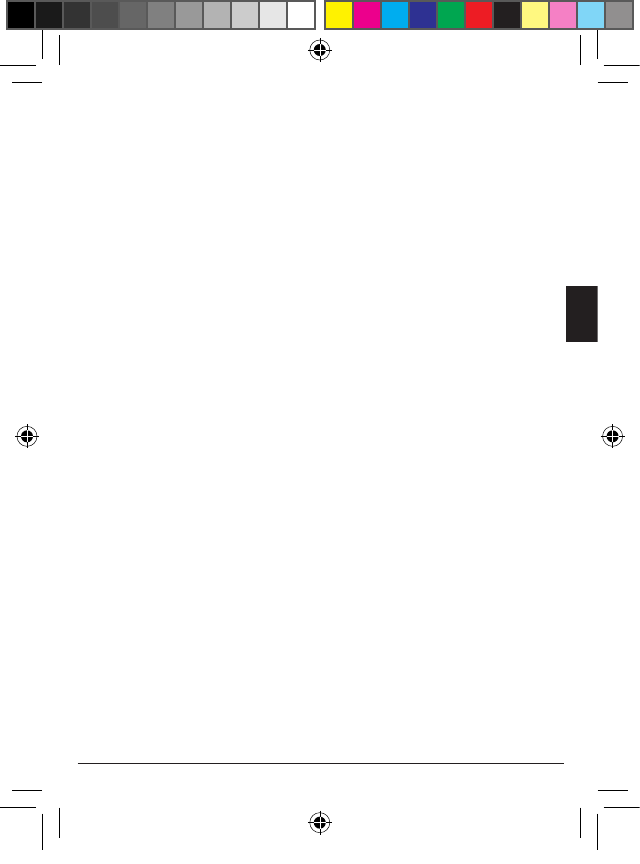
23
Cet appareil est conforme aux sections 15 des réglements de la FCC et à CNR-
210 d’Industrie Canada. Le fonctionnement aux deux conditions suivantes : (1)
Cet appareil ne doit pas provoquer d’interférences gênantes et (2) l’utilisateur de
cet appareil doit accepter les interférences reçues, y compris les interférences
pouvant provoquer un fonctionnement non désiré. Cet équipement a été testé et
jugé en conformité avec les limites aérentes à un appareil numérique de classe
B, en vertu de la section 15 des règlements de la FCC. Ces normes sont conçues
pour assurer une protection raisonnable contre les interférences nuisibles dans
un environnement résidentiel. Cet appareil génère, utilise et peut émettre de
l’énergie radioélectrique et, s’il n’est pas installé ou utilisé selon les directives,
peut causer des interférences nuisibles aux communications radio. Cependant, il
n’existe aucune garantie que des interférences ne se produiront pas dans une
installation particulière. Si cet appareil est la source d’interférences nuisibles
pour la réception des ondes de radio ou de télévision, ce qui peut être déterminé
en mettant
l’appareil hors tension, puis sous tension, il est recommandé de tenter
d’éliminer ces interférences en appliquant l’une ou plusieurs des mesures suivantes :
– Réorienter ou déplacer l’antenne réceptrice.
– Éloigner l’appareil du récepteur.
– Brancher l’appareil dans une prise d’un circuit diérent de celui qui alimente le
récepteur.
–
Consulter le détaillant ou un technicien radio ou télévision qualifié pour obtenir
de l’aide.
Avertissement de la FCC : tout changement ou toute modification
non ex-
pressément approuvés par la partie responsable de la
conformité pourrait
entraîner l’annulation des droits d’utilisation
de cet appareil.
150113_Phonak_Sicherheitshinweise_de indd 23 18 04 13 09 45

24
Section 5.0 Haut-parleurs Roger SoundField
5.1 Autres informations importantes
Le signal numérique envoyé par l’émetteur de l’appareil au récepteur
connecté ne
peut pas être entendu par d’autres appareils non intégrés au réseau de l’émetteur.
5.2 Déclaration de Conformité
Par la présente, Phonak Communications AG, Länggasse 17, CH-3280 Murten,
déclare que le produit Phonak est conforme aux
exigences principales et autres
dispositions pertinentes de la directive
1999/5/CE. Pour obtenir une copie de la
Déclaration de conformité, veuillez contacter le fabricant ou le représentant
Phonak local dont l’adresse figure sur la liste du site www.phonak.com (sites à
travers le monde).
Cet appareil est conforme aux sections 15 des réglements de la FCC et à CNR-210
d’Industrie Canada. Le fonctionnement aux deux conditions suivantes : (1) Cet
appareil ne doit pas provoquer d’interférences gênantes et (2) l’utilisateur de cet
appareil doit accepter les interférences reçues, y compris les interférences pouvant
provoquer un fonctionnement non désiré. Cet équipement a été testé et jugé en
conformité avec les limites aérentes à un appareil numérique de classe B, en
vertu de la section 15 des règlements de la FCC. Ces
normes sont conçues pour
assurer une protection raisonnable contre
les interférences nuisibles dans un
environnement résidentiel. Cet appareil génère, utilise et peut émettre de l’énergie
radioélectrique et, s’il n’est pas installé ou utilisé selon les directives, peut causer
des interférences nuisibles aux communications radio. Cependant, il n’existe
aucune garantie que des interférences ne se produiront pas dans une installation
particulière. Si cet appareil est la source d’interférences nuisibles pour la réception
des ondes de radio ou de télévision, ce qui peut être déterminé en mettant l’appareil
hors tension, puis sous tension, il est recommandé de tenter d’éliminer ces inter-
férences en appliquant l’une ou plusieurs des mesures suivantes :
150113_Phonak_Sicherheitshinweise_de indd 24 18 04 13 09 45
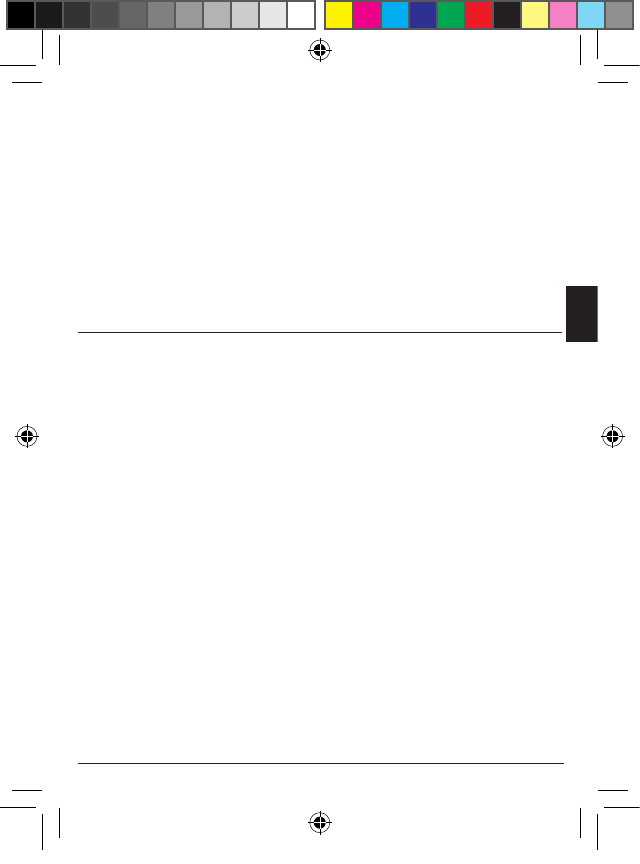
25
– Réorienter ou déplacer l’antenne réceptrice.
– Éloigner l’appareil du récepteur.
– Brancher l’appareil dans une prise d’un circuit diérent de celui qui alimente le
récepteur.
–
Consulter le détaillant ou un technicien radio ou télévision qualifié
pour obtenir
de l’aide.
Avertissement de la FCC : tout changement ou toute modification
non
expressément approuvés par la partie responsable de la
conformité pourrait
entraîner l’annulation des droits d’utilisation
de cet appareil.
6.0 Service et garantie
Garantie locale
Veuillez consulter l’audioprothésiste à l’endroit où vous avez acheté votre appareil
au sujet des conditions de la garantie locale.
Garantie internationale
Phonak propose une garantie internationale limitée d’un an, valide à compter de
la date d’achat. Cette garantie limitée couvre tous les défauts de fabrication et
matériels. La garantie est uniquement valide sur présentation d’une preuve
d’achat.
La garantie internationale n’aliène aucun des droits légaux dont vous pouvez
bénéficier selon votre législation nationale régissant la vente de produits de
consommation.
150113_Phonak_Sicherheitshinweise_de indd 25 18 04 13 09 45

26
Limitation de garantie
Cette garantie ne couvre pas les dommages dus à une manipulation ou un entretien
inadaptés, l’exposition à des produits chimiques, l’immersion dans l’eau ou une
sollicitation excessive. Les dommages causés par des tiers ou des centres de service
non autorisés annulent
la garantie. Cette garantie ne couvre pas les services
eectués par un audioprothésiste dans son bureau.
Numéro de série:
Date d’achat :
Audioprothésiste
autorisé
(tampon/signature) :
150113_Phonak_Sicherheitshinweise_de indd 26 18 04 13 09 45

150113_Phonak_Sicherheitshinweise_de indd 27 18 04 13 09 45

029-3149 / V1.00 / 2013-04 / visu’l Printed in Vietnam © Phonak AG All rights reserved
150113_Phonak_Sicherheitshinweise_de indd 28 18 04 13 09 45